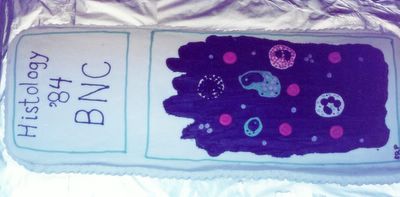
Strange cake. (Click picture to view larger image)

Update at end of post - 9/13, 11PM.
"Aristotle was famous for knowing everything. He taught that the brain exists merely to cool the blood and is not involved in the process of thinking. This is true only of certain persons." ~ Will CuppyI attended a small Christian college in Bethany, Oklahoma. BNC had a reputation for their science curriculum and I loved Biology; in fact I planned on majoring in Biology and minoring in English. Things changed and the end result was a double major in Chemistry and Zoology. After medical school and residency I went back to Oklahoma and into a Pathology practice group. One subject area that was lacking in the pre-med courses was in histology. There was no course set up. Through the years in school and residency I helped them purchase a set of histology slides and Dr. Y set up a self-study upper division histology course there.
In 1984, Dr. Y took a semester for sabbatical and asked if I would actually teach a histology class. It would be the first "lecture" type histology course for the students. We arranged it for an evening class, twice a week. We used the same text they would use in medical school. The tests would be the same format as what they would face there and lab practicals would also be set up.
The tests in medical school were something to be reckoned with. A mixture of multiple choice, true/false and matching. What is so different about that? The multiple choice were "multiple" multiple choice. Example: Four statements were given. You were to choose "A" if 1,2,& 3 are correct; "B" if 1 & 3 are correct; "C" if 2 & 4 are correct; "D" if 4 is correct; "E" if all are correct or "F" if none are correct. You might know all but one small fact and miss the whole question. The true/false are not straight forward either. Two statements are given and the answers were as follows: "A" if both are true and related; "B" if both are true but unrelated; "C" if #1 is true and #2 is false; "D" if #1 is false and #2 is true; "E" if both are false. The matching were fairly straight forward, except you could use the same answer multiple times and they always stuck an answer in that said "none applicable". The lab practicals were set up with structures to be identified on microscopic slides using the school's scopes.
I started with eight students. After the first test, we were down to four. One young man was bright, dedicated and above all, excited about the class. He consistently did well on the tests and practicals and earned the only A in the course. Another fellow did moderately well, but there was just not that spark you see if someone enjoys learning. He petitioned for a change in his grade from a B to an A but I had to show him that there was just too great of a gap between his performance and that of the top student. They both earned the grades they received. Oh, yes the last two received C's and were happy to get them.
To celebrate the end of the semester, I made this "blood smear" cake. It is a real cake with real buttercream icing and we did eat it. The students could identify the cellular components which would have been impossible prior to the course, so I felt much gratification. Now I know poopsie can name these cells with her eyes shut; no, maybe not shut, just squinting; but can anyone else? A hint you say? OK. There are red cells, platelets, neutrophil, basophil, eosinophil, monocyte and lymphocyte. Which is which. Hmm. I wonder.
Update: OK, here are the answers to the cake quiz! It really was a good cake, not creepy at all.

No comments:
Post a Comment